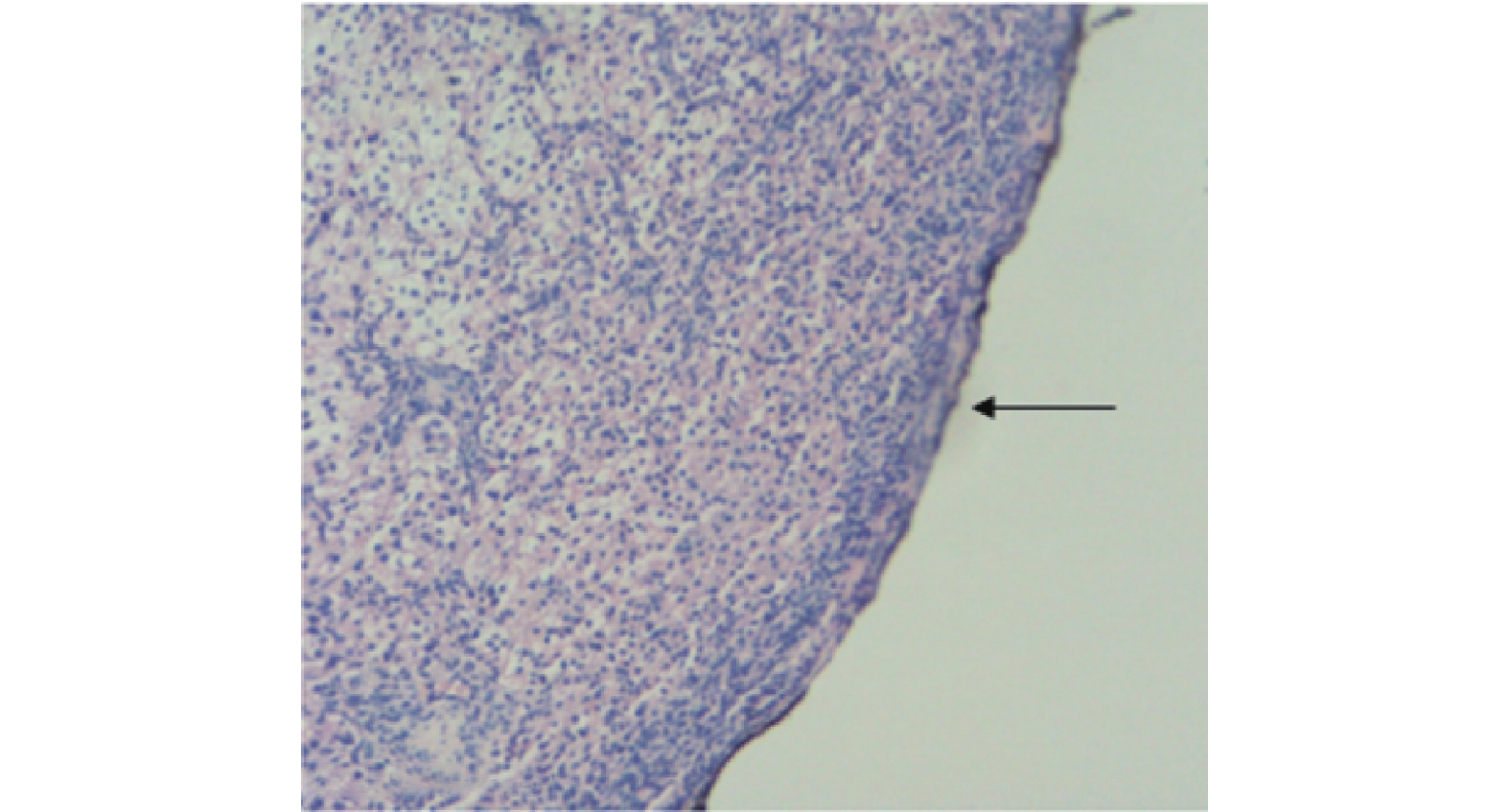T1b期肾癌行保留肾单位手术最佳切缘的探讨
The Optimal Surgical Margins of Nephron-sparing Surgery for Stage T1b Renal Tumors
-
摘要:目的 分析T1b期肾癌病理学特点,同时探讨该期肾癌行保留肾单位手术的最佳手术切缘。方法 回顾性分析2013年9月−2017年12月于我院行手术治疗的245例T1b期肾癌患者的临床及病理资料。结果 245例患者中男158例,女87例,平均年龄59.6岁,平均肿瘤大小5.3 cm。行根治性肾切除术者174例,保留肾单位手术者71例。术后病理学检查为肾透明细胞癌209例(85.3%),219例(89.4%)患者瘤体周围可见明显假包膜,其中26例(10.6%)患者肿瘤细胞穿透假包膜并侵入周围肾实质,浸润深度在1 mm、1~2 mm和2~3 mm的肿瘤分别为7例(26.9%)、16例(61.5%)和3例(11.5%)。24例(9.8%)患者可见多发性肿瘤。肾部分切除术的平均切缘为5 mm(3~7 mm)。结论 保留肾单位手术可用于T1b期肾癌,为避免切缘阳性,切缘距肿瘤表面应至少3 mm。Abstract:Objective To analyze the pathological characteristics and explore the optimal surgical margins (SM) of nephron-sparing surgery (NSS) for stage T1b renal carcinoma (4–7 cm) on preoperative imaging.Methods The clinical and pathological data of 245 cases of stage T1b kidney cancer from September 2013 to December 2017 were collected and reviewed retrospectively. The radical nephrectomy (RN) was performed on 174 cases and other 71 cases accepted NSS. There were 158 males and 87 females, with a mean age of 59.6 years and mean tumor size of 5.3 cm.Results Through postoperative pathological examination, 209 (85.3%) cases were confirmed renal clear cell carcinoma and 219 (89.4%) cases were surrounded with visible peritumoralpseudocapsule (PC). 26 (10.6%) cases of cancerous cells invaded beyond peritumoral PC and into renal parenchyma. The infiltrative depth into renal parenchyma beyond PC was all limited in 3 mm and the cases of ≤1, 1-2 and 2-3 mm were 7 (26.9%), 16 (61.5%) and 3 (11.5%), respectively. Multifocal tumors were discovered in 24 (9.8%) cases. The average resection margin for partial nephrectomy was 5 mm (3-7 mm).Conclusion For stage T1b renal tumors, NSS is acceptable and a 3 mm of surgical margin is safe and suitable to avoid positive SM.
-
Keywords:
- Renal tumors /
- Nephron-sparing surgery /
- Surgical margins /
- Pseudocapsule
-
肾癌即肾细胞癌,是泌尿系统常见的恶性肿瘤之一,近年来在全球范围内发病率呈现逐渐上升的趋势[1]。2010年美国癌症联合会(AJCC)将局限在肾包膜内、肿瘤最大直径≤ 4 cm的肾癌定义为T1a期,将4 cm <最大直径≤ 7 cm的肾癌定义为T1b期[2]。保留肾单位手术(nephron-sparing surgery, NSS)是目前临床上治疗大多数T1a期肾癌的标准术式,对于T1b期肾癌,根治性肾切除术(radical nephrectomy, RN)是其标准术式,部分T1b期肾癌患者也可以选择NSS[3]。然而,如何确定T1b期肿瘤的NSS最佳手术切缘仍存在广泛争议[4-5]。本研究收集了2013年9月−2017年12月于我院行手术治疗的245例T1b期肾癌患者的临床及病理资料,回顾性分析其组织学特点,为T1b期肾癌行NSS手术时选择合适切缘厚度提供理论依据。
1. 对象与方法
1.1 一般资料
本组T1b期肾癌患者共245例,男158例(64.5%),女87例(35.5%),男/女为1.82,平均年龄59.6岁(31~82岁),平均肿瘤直径5.3 cm(4.2~7.0 cm),左肾肿瘤114例(46.5%),右肾肿瘤131例(53.5%)。所有患者均经术前影像学检查证实为单侧肿瘤,且无明显其他部位转移病灶。46例(18.8%)患者因肉眼血尿就诊,34例(13.9%)为肾区疼痛,21例(8.6%)患者并发上述症状,其余144例(58.8%)患者无明显不适,因体检发现肾脏占位就诊。RN组患者174例,NSS组患者71例。NSS组纳入标准:①经影像及病理活检证实为肾脏肿瘤;②单侧发病;③术前RENAL评分7~8分[6];④无远处转移;⑤健侧肾功能正常;⑥年龄≤75 岁;⑦患者及家属知情同意。NSS组排除标准:术前RENAL评分>8分[6]。RN组纳入标准:NSS组排除的适宜手术患者。手术排除标准:①存在手术禁忌症;②合并其他恶性肿瘤;③合并自身免疫性疾病;④合并全身急慢性感染。本研究通过河北北方医学院附属第一医院生物医学伦理委员会审批(编号2014012)。
1.2 组织学分析
RN组切除的完整肾脏在体外行NSS手术,术中沿肿瘤边缘5~10 mm正常肾组织完成切除肿瘤,具有假包膜结构的肿瘤应尽可能保持其完整性,后送至河北北方学院附属第一医院病理科检查。所有标本均经甲醛溶液固定后常规石蜡包埋,连续切片后行HE及免疫组化染色进行诊断。对于肿瘤细胞穿透假包膜的标本,显微镜下标记并测量肿瘤最大浸润深度,所有诊断均由至少2名病理科医师阅片后确定。
1.3 术后观察指标
两组患者术后均未发生漏尿、切口感染、高热等并发症。NSS组出血1例,栓塞治疗后痊愈;首次复查时间为术后3个月,复查血常规、肝肾功能、电解质、肾小球滤过率(GFR) 等;术后2年内每3个月复查腹部、胸部CT,2年后每6个月复查1次,明确肿瘤有无复发及转移情况。
2. 结果
经术后病理学检查,本组209例(85.3%)患者为肾透明细胞癌,12例(4.9%)患者为嫌色细胞癌,15例(6.1%)患者为乳头状腺癌,其他类型肾癌共9例(3.7%),NSS组和RN组患者病理类型差异无统计学意义(表1)。Fuhrman分级提示1级43例(17.6%),2级180例(73.5%),3级18例(7.3%),4级4例(1.6%)。肿瘤被覆假包膜者219例(89.4%),其中193例(88.1%)瘤周假包膜完整无缺损(图1A、1B),26例(11.9%)假包膜被肿瘤细胞穿透进入正常肾实质(图1C)。肿瘤细胞浸润深度均在3 mm之内,其中,≤ 1 mm者7例(26.9%),>1~2 mm者16例(61.5%),>2~3 mm者3例(11.5%),两组患者肿瘤浸润深度差异无统计学意义(表2)。存在多发肿瘤或“卫星灶”者24例(9.8%)(图2),其中11例(45.8%)经术前B超或CT检查发现,其余13例(54.2%)均为RN标本经术后病理检查确定。
表 1 pT1b肾癌患者临床及病理资料(n=245)Table 1. Clinical and pathological characteristics of pT1b renal cell carcinoma patients (n=245)Variable NSS group
(n=71)RN group
(n=174)P Gender/case (%) 0.46 Male 43 (60.6) 115 (66.1) Female 28 (39.4) 59 (33.9) Age/yr., median (P25-P75) 64 (31-79) 61 (49-82) 0.62 Tumor diameter/cm, median (P25-P75) 5.2 (4.2-7.0)
5.5 (4.5-7.0)
0.22
Laterality/case (%) 0.06 Left 40 (56.3) 74 (42.5) Right 31 (43.7) 100 (57.5) Tumor histologic type/case (%) 0.93 Clear cell 61 (85.9) 148 (85.1) Chromophobe 3 (4.2) 9 (5.2) Papillary 5 (7.1) 10 (5.7) Others 2 (2.8) 7 (4.0) Fuhrman grade/case (%) 0.83 1 13 (18.3) 30 (17.2) 2 52 (73.2) 128 (73.6) 3 5 (7.1) 13 (7.5) 4 2 (2.8) 2 (1.2) Pseudocapsule/case (%) 0.64 Present 63 (88.7) 156 (89.7) Absent 8 (11.3) 16 (9.2) Multifocal carcinoma/case (%) 0.81 Present 6 (8.5) 18 (10.3) Absent 65 (91.5) 156 (89.7) NSS: Nephron-sparing surgery; RN: Radical nephrectomy ![]() 图 1 不同状态的瘤周假包膜示意图。 HE ×100Figure 1. Schematic diagram of peritumoral pseudocapsule in different states. HE ×100A: The pseudocapsule was complete without tumor cell infiltration; B: Tumor cells infiltrated the pseudocapsule but did not penetrate; C: Tumor cells penetrate the pseudocapsule into the renal parenchyma. PC: Pseudocapsule; T: Tumor; K: Kidney表 2 肿瘤穿透假包膜并侵犯肾实质的最大浸润深度Table 2. The maximum depth of invasion of the tumor through the pseudocapsule and invading the renal parenchyma
图 1 不同状态的瘤周假包膜示意图。 HE ×100Figure 1. Schematic diagram of peritumoral pseudocapsule in different states. HE ×100A: The pseudocapsule was complete without tumor cell infiltration; B: Tumor cells infiltrated the pseudocapsule but did not penetrate; C: Tumor cells penetrate the pseudocapsule into the renal parenchyma. PC: Pseudocapsule; T: Tumor; K: Kidney表 2 肿瘤穿透假包膜并侵犯肾实质的最大浸润深度Table 2. The maximum depth of invasion of the tumor through the pseudocapsule and invading the renal parenchymaThe maximum depth of invasion NSS group (n=71) RN group (n=174) P ≤1 mm/case (%) 3 (4.2) 4 (2.3) 0.26 >1-2 mm/case (%) 3 (4.2) 13 (7.5) 0.23 >2-3 mm/case (%) 1 (1.4) 2 (1.2) 0.79 >3 mm/case (%) 0 (0) 0 (0) − NSS: Nephron-sparing surgery; RN: Radical nephrectomy 71例行NSS的患者手术切缘为3~7 mm,平均切缘为5 mm。3例(4.2%)患者切除标本经术后病理检查发现阳性切缘(图3),该3例患者的的手术切缘分别是 3 mm、 5 mm、7 mm,切除组织的病理检查均存在肿瘤细胞穿透假包膜的情况,最大浸润深度分别为 0.9 mm、1.4 mm及2.7 mm。此3例患者中,2例患者分别于术后7、13个月发现肿瘤局部复发,后接受RN治疗;另1例经8个月随访,暂无肿瘤复发迹象,3例患者均未发现淋巴结或远处器官转移灶。
245例患者均获得随访,随访率100%,平均随访40个月(28−60个月),NSS组术后患侧GFR平均下降18 mL/min(15~30 mL/min),肿瘤局部复发1例,行根治性肾切除。RN组局部复发2例,远处转移5例,均采用靶向治疗,死亡4例。
3. 讨论
肾癌是一种常见的泌尿系统肿瘤,约占成人恶性肿瘤的2%~3%,近年来发病率逐年升高[7]。外科手术是局限性肾癌的首选治疗方法,与RN相比,NSS可保留更多的健康肾组织,对肾功能的损伤更小[8-9]。T1b期肾癌患者是否可行NSS目前尚有争议,LEIBOVICH等[10]回顾性分析了91例经NSS治疗及841例经RN治疗的T1b期肾癌患者的资料,发现两组患者的5年肿瘤特异性生存率及远处转移率均无明显差异,LEE等[11]的研究也证实了上述结果。
阳性手术切缘(positive surgical margins, PSM)是指病理检查提示切缘上有明确的肿瘤细胞残留。虽然PSM是否会引起肾癌患者肿瘤局部复发或远处转移目前尚无定论,但为避免PSM的发生,明确NSS的最佳手术切缘非常必要。ZUCCHI等[12]研究认为对T1b期肾癌行NSS手术时,切缘距肿瘤表面10 mm即可避免PSM,同时降低肿瘤复发的风险。然而,有学者认为10 mm的切缘会引起正常肾组织的过度切除,导致术后并发症如术后出血、集合系统损伤、漏尿等发生率增加。AKCETIN等[13]发现对于直径<5 cm的肿瘤,NSS的切缘宽度对患者远期肾功能及生存率无明显影响,即使切缘小于2 mm。国内秦晓健等[14]认为NSS治疗临床T1b期肾癌是安全、有效的,合适切缘为肾表面距肿瘤0.5 cm,基底距肿瘤0.2 cm。CHEN等[15]分析了87例T1b期肾癌组织标本,发现34例(39.1%)存在肿瘤穿透假包膜的情况,且浸润深度在1、2、3 mm内的分别为10例(11.5%)、18例(20.7%)及6例(6.9%)。而本次研究共纳入了71例行NSS治疗的T1b期肾癌患者,肿瘤直径位于4.2~7.0 cm之间,平均直径为5.3 cm,切缘范围为3~7 mm,平均切缘为5 mm,其中切缘阳性的3例患者分别据切缘3 mm、5 mm、7 mm,且该3例患者均存在肿瘤穿透假包膜的情况,同时我们发现癌细胞穿透假包膜、浸润肾实质的深度均在3 mm之内,因此,笔者认为对T1b期肾癌行NSS时,为避免PSM,手术切缘应≥3 mm。
多发性肿瘤的存在是限制NSS手术可行性的另一主要因素。RICHSTONE等[16]分析了1 071例经RN切除的完整肾脏,发现57例(5.3%)标本中存在多灶肿瘤,其中,经术前影像学检查发现者仅19例(1.8%)。SARGIN等[17]研究发现13.1%(16/122)的肾癌伴有卫星灶,且93.8%(15/16)的卫星灶病理类型与原发肿瘤相同,多发癌灶的出现与肿瘤的分级和分期相关,而与病灶大小及病理类型无关。一项纳入了5 378例经RN或NSS治疗的肾癌患者的回顾性分析显示多发性肿瘤约占总体的4.6%,并且其与患者的5年及10年肿瘤特异性生存率明显相关(P<0.001)[18]。不同学者报道的多灶性肾癌发病率差异较大,该差异可能是由于病理检查的评定标准不一致造成的。本研究中,多发肾癌共24例,其中11例(45.8%)是通过术前影像学检查确定的,其余13例(54.2%)均由病理检查发现。既往研究报道,经术前泌尿系彩超、CT或MRI等手段检测到的多灶肿瘤仅占总体的13.1% ~ 44%[17],本研究与既往文献类似,多发癌灶的出现与肿瘤的分级和分期相关,而与病灶大小及病理类型无关,本次研究中NSS组和RN组的病灶亦无差异。有学者认为NSS手术会引起肿瘤微小卫星灶的残留,继而导致PSM及肿瘤局部复发,然而,残留病灶是否最终导致淋巴结或远处器官转移目前仍无定论[5, 19]。
总之,T1b期肾癌行NSS手术时,为避免术后PSM及肿瘤局部复发,我们的经验如下:①手术切缘距肿瘤表面应至少3 mm,若肿瘤呈明显浸润状态,可对切缘组织行快速冰冻病理检查以明确是否完全切除癌灶;若瘤周假包膜结构完整,不推荐冰冻病理检查;②借助术前影像学检查及术中探查尽可能明确是否存在多发肿瘤,若存在,应选择RN治疗;③患者术后应密切随访,对于出现局部复发者,应及时行RN治疗。
-
图 1 不同状态的瘤周假包膜示意图。 HE ×100
Figure 1. Schematic diagram of peritumoral pseudocapsule in different states. HE ×100
A: The pseudocapsule was complete without tumor cell infiltration; B: Tumor cells infiltrated the pseudocapsule but did not penetrate; C: Tumor cells penetrate the pseudocapsule into the renal parenchyma. PC: Pseudocapsule; T: Tumor; K: Kidney
表 1 pT1b肾癌患者临床及病理资料(n=245)
Table 1 Clinical and pathological characteristics of pT1b renal cell carcinoma patients (n=245)
Variable NSS group
(n=71)RN group
(n=174)P Gender/case (%) 0.46 Male 43 (60.6) 115 (66.1) Female 28 (39.4) 59 (33.9) Age/yr., median (P25-P75) 64 (31-79) 61 (49-82) 0.62 Tumor diameter/cm, median (P25-P75) 5.2 (4.2-7.0)
5.5 (4.5-7.0)
0.22
Laterality/case (%) 0.06 Left 40 (56.3) 74 (42.5) Right 31 (43.7) 100 (57.5) Tumor histologic type/case (%) 0.93 Clear cell 61 (85.9) 148 (85.1) Chromophobe 3 (4.2) 9 (5.2) Papillary 5 (7.1) 10 (5.7) Others 2 (2.8) 7 (4.0) Fuhrman grade/case (%) 0.83 1 13 (18.3) 30 (17.2) 2 52 (73.2) 128 (73.6) 3 5 (7.1) 13 (7.5) 4 2 (2.8) 2 (1.2) Pseudocapsule/case (%) 0.64 Present 63 (88.7) 156 (89.7) Absent 8 (11.3) 16 (9.2) Multifocal carcinoma/case (%) 0.81 Present 6 (8.5) 18 (10.3) Absent 65 (91.5) 156 (89.7) NSS: Nephron-sparing surgery; RN: Radical nephrectomy 表 2 肿瘤穿透假包膜并侵犯肾实质的最大浸润深度
Table 2 The maximum depth of invasion of the tumor through the pseudocapsule and invading the renal parenchyma
The maximum depth of invasion NSS group (n=71) RN group (n=174) P ≤1 mm/case (%) 3 (4.2) 4 (2.3) 0.26 >1-2 mm/case (%) 3 (4.2) 13 (7.5) 0.23 >2-3 mm/case (%) 1 (1.4) 2 (1.2) 0.79 >3 mm/case (%) 0 (0) 0 (0) − NSS: Nephron-sparing surgery; RN: Radical nephrectomy -
[1] LEBACLE C, POOLI A, BESSEDE T, et al. Epidemiology, biology and treatment of sarcomatoid RCC: current state of the art. World J Urol,2019,37(1): 115–123. DOI: 10.1007/s00345-018-2355-y
[2] EDGE S B, COMPTON C C. The American Joint Committee on Cancer: the 7th edition of the AJCC cancer staging manual and the future of TNM. Ann Surg Oncol,2010,17(6): 1471–1474. DOI: 10.1245/s10434-010-0985-4
[3] CAPITANIO U, TERRONE C, AATONELLI A, et al. Nephron-sparing techniques independently decrease the risk of cardiovascular events relative to radical nephrectomy in patients with a T1a-T1b renal mass and normal preoperative renal function. Eur Urol,2015,67(4): 683–689. DOI: 10.1016/j.eururo.2014.09.027
[4] COOPERBERG M R, MALLIN K, KANE C J, et al. Treatment trends for stage I renal cell carcinoma. J Urol,2011,186(2): 394–399. DOI: 10.1016/j.juro.2011.03.130
[5] ZHANG K, XIE W L. Determination of the safe surgical margin for T1b renal cell carcinoma. Urol J,2017,14(1): 2961–2967.
[6] KUTIKOV A, UZZO R G. The R.E.N.A.L. nephrometry score: a comprehensive standardized system for quantitating renal tumor size, location and depth. J Urol,2009,182(3): 844–853. DOI: 10.1016/j.juro.2009.05.035
[7] FERLAY J, SHIN H R, BRAY F, et al. Estimates of worldwide burden of cancer in 2008: GLOBOCAN 2008. Int J Cancer,2010,127(12): 2893–2917. DOI: 10.1002/ijc.25516
[8] SHIN S J, KO K J, KIM T S, et al. Trends in the use of nephron-sparing surgery over 7 years: an analysis using the R.E.N.A.L. nephrometry scoring system. PLoS One,2015,10(11): e0141709[2019-07-02]. https://doi.org/10.1371/journal.pone.0141709.
[9] 晁流, 刘宁, 甘卫东, 等. 保留肾单位术与根治性肾切除术对肾功能影响的比较. 中华腔镜泌尿外科杂志(电子版),2017,11(6): 393–397. DOI: 10.3877/cma.j.issn.1674-3253.2017.06.009 [10] LEIBOVICH B C, BLUTE M, CHEVILLE J C, et al. Nephron sparing surgery for appropriately selected renal cell carcinoma between 4 and 7 cm results in outcome similar to radical nephrectomy. J Urol,2004,171(3): 1066–1070. DOI: 10.1097/01.ju.0000113274.40885.db
[11] LEE H J, LISS M A, DERWEESH I H. Outcomes of partial nephrectomy for clinical T1b and T2 renal tumors. Curr Opin Urol,2014,24(5): 448–452. DOI: 10.1097/MOU.0000000000000081
[12] ZUCCHI A, MEARINI L, MEARINI E, et al. Renal cell carcinoma: histological findings on surgical margins after nephron sparing surgery. J Urol,2003,169(3): 905–908. DOI: 10.1097/01.ju.0000046779.58281.c4
[13] AKCETIN Z, ZUGOR V, ELSASSER D, et al. Does the distance to normal renal parenchyma (DTNRP) in nephron-sparing surgery for renal cell carcinoma have an effect on survival? Anticancer Res,2005,25(3A): 1629–1632.
[14] 秦晓健, 张海梁, 叶定伟, 等. 临床T1b期肾癌选择性保留肾单位手术分析. 中华泌尿外科杂志,2013,34(3): 167–170. DOI: 10.3760/cma.j.issn.1000-6702 [15] CHEN X S, ZHANG Z T, DU J, et al. Optimal surgical margin in nephron-sparing surgery for T1b renal cell carcinoma. Urology,2012,79(4): 836–839. DOI: 10.1016/j.urology.2011.11.023
[16] RICHSTONE L, SCHERR D S, REUTER V R, et al. Multifocal renal cortical tumors: frequency, associated clinicopathological features and impact on survival. J Urol,2004,171(2 Pt 1): 615–620. DOI: 10.1097/01.ju.0000106955.19813.f6
[17] SARGIN S Y, EKMEKCIOGLU O, ARPALI E, et al. Multifocality incidence and accompanying clinicopathological factors in renal cell carcinoma. Urol Int,2009,82(3): 324–329. DOI: 10.1159/000209366
[18] SIRACUSANO S, NOVARA G, ANTONELLI A, et al. Prognostic role of tumourmultifocality in renal cell carcinoma. BJU Int,2012,110(11 Pt B): E443–E448. DOI: 10.1111/j.1464-410X.2012.11121.x
[19] LI G, LUO Q, LANG Z, et al. Histopathologic analysis of stage pT1b kidney neoplasms for optimal surgical margins of nephron-sparing surgery. Clin Trans Oncol,2018,20(9): 1196–1201. DOI: 10.1007/s12094-018-1845-0
-
期刊类型引用(2)
1. 韩明,燕群峰,叶明宝,王亚辉,杜昌国,王延滨,任磊. 保留肾单位手术在局限性肾癌患者中的应用效果. 癌症进展. 2022(01): 74-76+92 .  百度学术
百度学术
2. 扈新,张玉泉,杨志平,郭志全,王海临. 后腹腔镜下保留肾单位手术与肾根治性切除术治疗T1b期肾肿瘤的近远期效果对比. 国际泌尿系统杂志. 2021(03): 431-434 .  百度学术
百度学术
其他类型引用(3)

 首页
首页


 下载:
下载:






